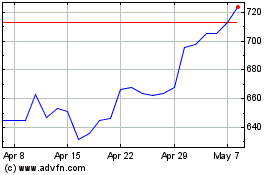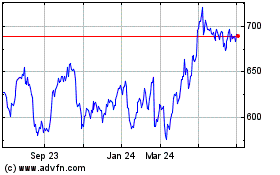By Justin Cash
Of Financial News
The proportion of women in the highest paying financial services
roles has ticked down.
Analysis by payroll data company Spktral provided to Financial
News shows that for the 2020-21 reporting cycle, the proportion of
women in the lowest pay quarter across financial services and
insurance companies rose to 59.3%, an increase of 1.3 percentage
points.
The proportion of women in the top quartile of pay dipped to
29.2%, a fall of 0.5 percentage points. The proportion in the upper
middle quarter also ticked down by 1.2 percentage points to 39.9
per cent.
The data will fuel further concerns about how women across the
workplace have been disproportionately impacted by the pandemic,
with the phrase "shecession" coined to describe an economic
downturn that has left millions more women worse off.
Since 2017, employers with more than 250 staff have had to
report their gender pay gap--the difference between the average
earnings of men and women across a workforce--to a government
portal.
The data for the Spktral analysis aggregated the submissions of
some 223 firms in the financial services and insurance sector, and
is based on the snapshot date of April 5, 2020. Under U.K.
government reporting rules, that data was due a month ago, on April
4.
While the Equality and Human Rights Commission has given a
six-month extension, out to Oct. 5, until it takes enforcement
action, Spktral business development executive Heather Williamson
noted that only just over 50% of financial services and insurance
firms have submitted so far, given that some 453 did so in the
previous reporting year.
"For the report due April 4, 2022, organizations should already
have everything they need to start preparing their analysis and
report, yet some are still looking at last year's report," she
said.
While there were increases in the median and mean gender pay gap
in the sector to 25.9% and 28% respectively, and the median and
median bonus gap, which hit 43.5% and 54.6%, Ms. Williamson argued
that issues such as representation at senior levels are just as
important as the overall gender pay gap.
"Our whole thing at the moment is that we shouldn't be focusing
on the pay-gap percentage, boiling a whole organization down to a
single figure, which can be unhelpful," she said. "Representation
is more important than the pay gap. Even with companies that have,
say a 60/40% split of women, you have to ask: Why are only 15% of
them in the top 25% [of earners]?"
"We do see people discounting gender pay-gap reporting, but
[women] are still not getting into the leadership part of the
company. That's what we're up against. If we can get more people
thinking about representation as well as just the pay gap then
that's definitely a new angle."
Bev Shah, founder of industry diversity group CityHive, says
that she has heard anecdotal accounts of women in middle-management
positions stepping back from their roles during the pandemic.
While there has been great growth in diverse City apprenticeship
and graduate recruitment schemes, such as 100blackinterns and
Investment 2020, Ms. Shah said not enough attention has been paid
to career progression once women join firms.
"Firms are just focusing on entry-level positions," she said.
"Interns and grad schemes are all great, but there's not a lot of
action happening in the middle because you can't grow that pool
organically. We're talking about experienced people; there's no
magic tree of women to pick from."
"Firms don't want to focus on what they need to change
structurally to keep those people on. You can bring in a million
but if you don't keep them, nothing is going to change."
Aggregate data is a starting point, Ms. Shah says, but has to be
"a stick to hit people with" to inspire action.
"If people don't take action it will start to show."
The Spktral data shows that entities within Barclays PLC, RBC
and HSBC Holdings PLC have the highest median pay gaps in the
sample.
Barclays had the highest median pay gap at 59.5%, and a mean pay
gap of 41.6%. The bank also had one of highest median bonus gaps in
the sample at 80.6% and a mean bonus gap of 58.8%.
RBC Europe had a median pay gap of 54%, a mean pay gap of 47%, a
median bonus gap of 80% and a mean bonus gap of 64%.
HSBC Bank had a median pay gap of 53.7%, and a mean pay gap of
54.4%, with a similar gap in its bonuses of 67.5% for the mean and
64.4% for the median figures.
Barclays said that the figures applied only to its head office
entity, which employs a small number of people. The bank declined
to provide a headcount figure, however.
For the Barclays U.K. business as a whole, the mean pay gap was
38.1%, the median 37.2%, and the mean and median bonus gaps were
49.2% and 67.6%.
RBC also said that the figures weren't representative of RBC in
the U.K. as a whole because they relate to one entity only.
The firm said its mean gender pay gap for 2020 was 38% for all
RBC U.K. entities and its median gender pay gap was 37%.
"We have made our commitment known through our Women in Finance
Charter pledge of having an initial target of 25% female
representation in senior roles across the British Isles by 2025," a
spokesman said. "At the entry level we are committed to sustaining
gender parity for our graduate intakes while at the senior level we
have committed to female representation on the decision-making
process for all new hires and promotion boards."
An HSBC spokeswoman says that the figures for HSBC Bank relate
to an entity with around 2,000 staff, but this is a smaller sample
that its largest U.K. entity, HSBC U.K., which has some 20,000
employees.
HSBC U.K. has a mean pay gap of 32.9% and a median pay gap of
20.2%, which it said is "more comparable to UK domestic peers" in
its latest gender pay gap report.
Website: www.fnlondon.com
(END) Dow Jones Newswires
May 07, 2021 03:57 ET (07:57 GMT)
Copyright (c) 2021 Dow Jones & Company, Inc.
Hsbc (LSE:HSBA)
Historical Stock Chart
From Mar 2024 to Apr 2024

Hsbc (LSE:HSBA)
Historical Stock Chart
From Apr 2023 to Apr 2024
